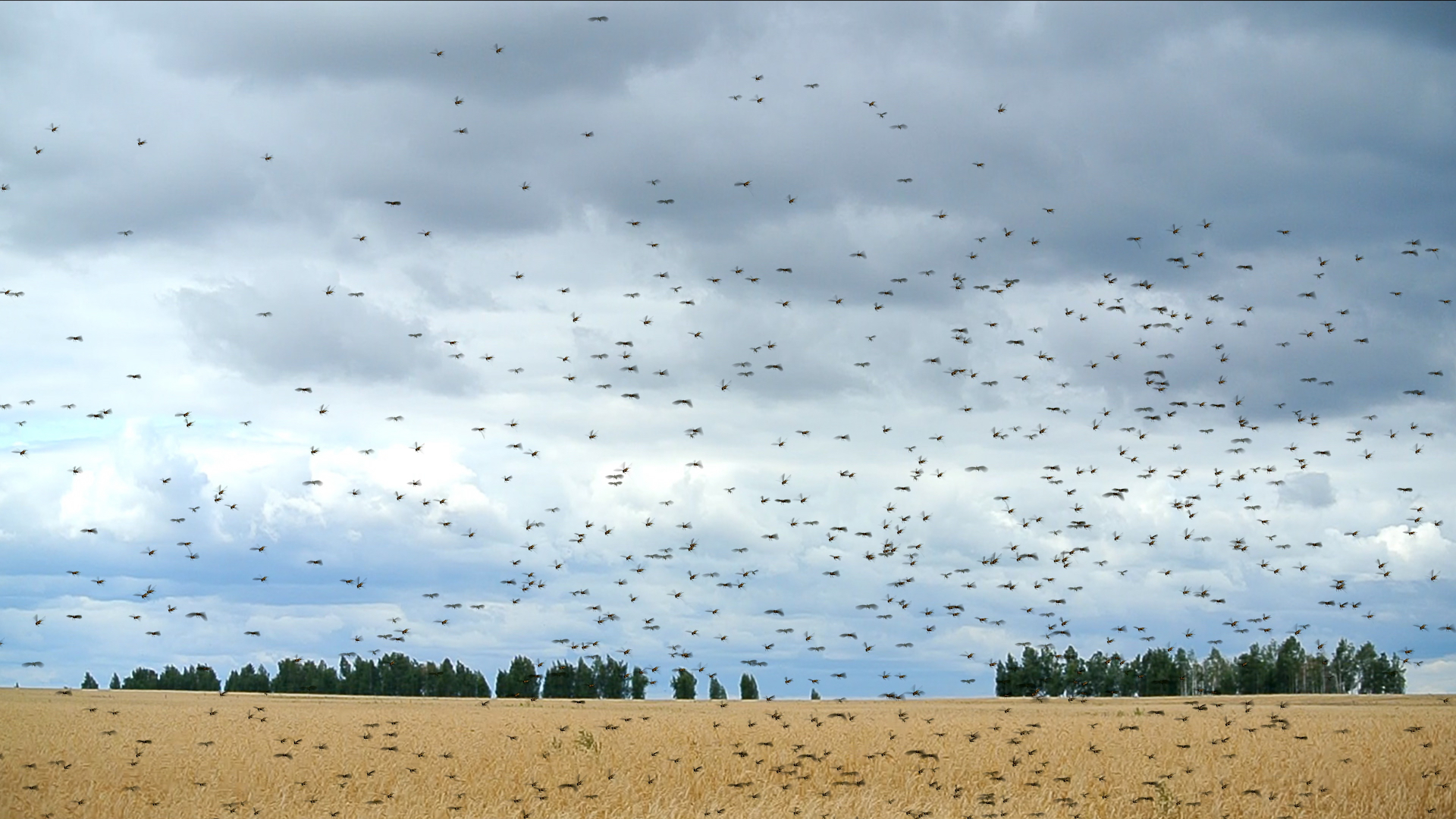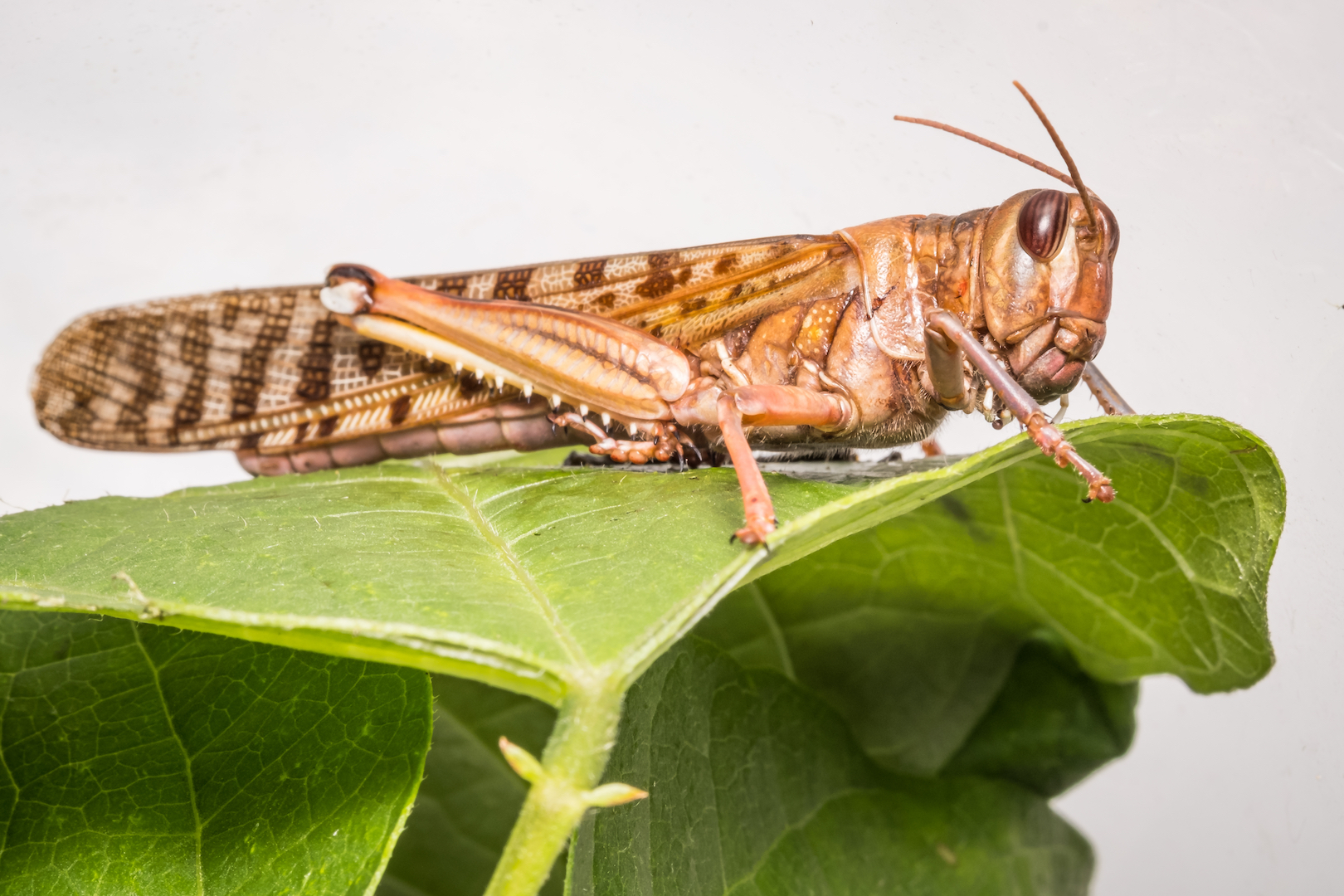What are locusts and why do they swarm?
Locust swarms cause complex agricultural, social, international challenges.

Locusts are large grasshoppers that live on almost every continent of the world and are known for their propensity to gather in large, destructive swarms. However, locusts often live for several generations, spanning decades, in the solitary, sedentary style that's characteristic of other species of grasshoppers. It's when locusts come together that their behavior changes.
Locusts are able to sense when their population density begins to increase, said Hojun Song, an entomologist at Texas A&M University. And in response, "they become gregarious, attracted to each other. They eat more [and] develop faster," he said.
Related: Grasshoppers vs. locusts: What makes a swarm?
But the conditions must be just right for locusts to join forces. Sudden rainfall, for example, could help feed a growing population and cause flooding that corrals locusts together and attract more locusts to join. What starts as a small group can turn into a thrumming swarm of thousands, millions or even billions of locusts. As part of this transformation, locusts may change color, Song said.
Some species of locusts become migratory, flying long distances across borders in search of food. The most devastating, best-known, and most frequently studied example is the desert locust (Schistocerca gregaria).
"Unlike other pests, which are localized, desert locusts can swarm and fly, and an entire region can be wiped out of crops," as the locusts come through and chow down, said Esther Ngumbi, an entomologist at the University of Illinois at Urbana-Champaign who studies agricultural pests and food insecurity. The enormous swarms of desert locusts can be utterly devastating for famers whose livelihoods depend solely on those crops, she said.
Locust phases: Shifting from solitary to swarming
There are about 20 species of locusts, and they all undergo a dramatic transformation when there are many other locusts of the same species nearby. The locusts shift from what scientists call the solitarious, or solitary phase when the locust is alone, to the gregarious phase when they swarm together.
Get the world’s most fascinating discoveries delivered straight to your inbox.
The specific signal that instigates the phase shift varies from species to species, Song said. For example, although both species react to the sight and smell of other locusts in a laboratory setting, the desert locust can shift into the gregarious phase with a touch on the hind legs, whereas the sensitive area on the Australian plague locust (Chortoicetes terminifera) is its antennae, he explained. These triggers seem to boost levels of serotonin, the same chemical associated with mood in humans.
Related: Image gallery: Striking photos of locust swarms
The two "Jekyll and Hyde" versions of the locust are an example of a phenomenon called "phenotypic plasticity." This happens when the genes of the animal go unchanged, but the behavior and physiology changes in response to external factors. "Certain traits are fixed, and certain traits change in response to the environment," Song said. "This is common across all life forms, including us."
One theory to explain why locusts adapted to have such phase changes, according to Song, is that the switch is a response to a changing environment. About 8 million years ago, as Northern Africa shifted from tropical forests to desert, migratory swarming locusts could hop from one oasis of vegetation to the next, or shift back to a solitary phase if there was plenty of food and space in one place.
Understanding the basic biology of locusts can provide insight into dealing with them as an agricultural pest, but also plays a part in the classic debate over the roles of nature and nurture — or genetic material and the environment — in shaping individuals.
Locust plagues
Locusts are found on every continent except Antarctica. In North America, the Rocky Mountain locust (Melanoplus spretus) has been extinct for a century, but other locust species remain in Mexico. Depending on the species, a flying locust swarm may travel hundreds of miles in search of food.
For instance, in 1988 a swarm flew from West Africa to the Caribbean, a journey of more than 3,100 miles (5,000 kilometers) in merely 10 days, according to National Geographic. The ability to traverse such distances make locusts "a continental challenge" as an agricultural pest, said Arianne Cease, director of the Global Locust Initiative at Arizona State University. Effective monitoring and management of locusts require international cooperation.
Related: The science of the 10 plagues
Locusts are herbivores, although there are reports of locust cannibalism when other food is scarce, Song said. A locust can eat its own weight in plant matter each day, which is only about 0.07 ounces (2 grams). But the largest locust swarms, called plagues, can number in the billions and together, a plague of locusts can consume so much plant material that they erase several months of growth before moving on, resulting in long-term effects on the health and finances of entire regions.
For example, a plague of desert locusts that originated in Western Africa in 2003 and lasted until 2005 affected 22 countries and reportedly wiped out over 80% of crops, according to a report from the Food and Agriculture Organization of the United Nations. By the time the plague finally declined in early 2005, the total cost of damage control efforts had reached half a billion dollars.
Some locust species, like the desert locust, normally live in the wilderness, Cease said. Monitoring for small outbreaks of these locust populations can help keep the problems manageable by suppressing the locusts before their swarm grows to a size large enough to cause national or multinational disasters.
Related: New weapon against desert locust plagues: Satellite images
Other locusts, such as the Sengalese grasshopper (Oedaleus senegalensis), may live in agricultural areas even when in the solitary phase. Careful land management, such as carefully selecting crops and how to grow them, and controlling nutrients in the soil can help discourage those locust swarms from forming, Cease said.
Locust plagues may last for years once they are in full swing, with multiple generations of swarming locusts. But the worst plagues are generally infrequent, and some species go decades between major population explosions. However, experts say this is an additional challenge for disaster preparedness because the threat of a locust swarm can seem less critical if it hasn't been an issue for many years.
How locusts affect humans
Although their swarming behavior doesn't happen often, locusts are typically thought of as fearsome pests prone to causing natural disasters. And although locusts don't bite people, people bite them. Locusts are edible and several cuisines around the world include locust recipes, such as peanut-stuffed locusts in Cambodia. But because modern farmers may use pesticides to protect their crops from locusts, eating locusts can be unsafe as they may be carrying residue from those pesticides.
Locusts are often confused with periodical cicadas, another type of large insect that shows up in large numbers every few years. Although cicadas may be called "locusts," they're technically not locusts, or even grasshoppers. Periodical cicadas synchronously emerge from the ground every 13 or 17 years, depending on the species, according to the National Wildlife Foundation.
Related: Gaddafi's fall leads to desert locusts' rise
In this era of human-driven climate change, experts warn that the threat of locust swarms may intensify. It's unclear exactly how climate change will affect all locust populations, but the insects are resilient, and some scientists have warned that the severity of locust plagues could worsen if conditions for locust swarming become more common. For instance, an increase in cyclones in Eastern Africa and the Arabian Peninsula, a weather condition favorable to locusts, could lead to higher locust numbers, according to National Geographic. "With climate change, insects are going to be a force to be reckoned with," Ngumbi told Live Science.
The worst consequences may be borne by people who bear little responsibility for the changing climate, such as small-scale farmers and those living in rural communities. Because locusts can wreak such incredible havoc on crops, food insecurity is legitimate concern, Ngumbi said.
Although people have lived with locusts for millennia, there are still many unanswered questions about how human activities may influence locust plague formation, Cease said. "How does the social system interact with the natural system?" she asked. The Global Locust Initiative's interdisciplinary research aims to find solutions for the international challenge of dealing with locust swarms and improve food stability worldwide.
Additional resources:
- Find out how researchers at Harvard University are studying locust swarms in East Africa.
- Watch locusts swarming in Madagascar in this video from CNN.
- Learn more about how locusts phase shift when their population begins to swell, from the Entomological Society of America.



